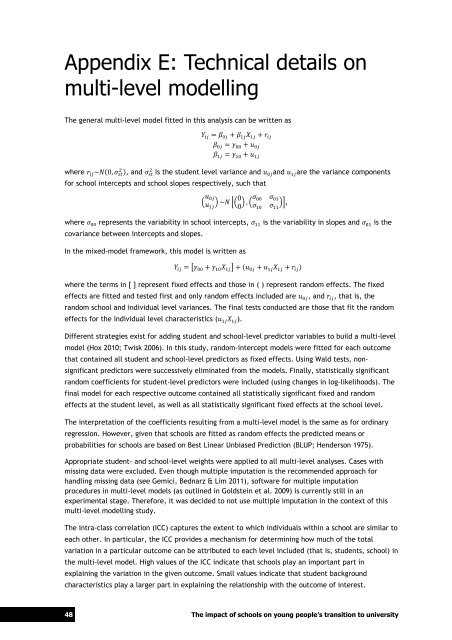The impact of schools on young people's transition to university
The impact of schools on young people's transition to university
The impact of schools on young people's transition to university
You also want an ePaper? Increase the reach of your titles
YUMPU automatically turns print PDFs into web optimized ePapers that Google loves.
Appendix E: Technical details <strong>on</strong><br />
multi-level modelling<br />
<str<strong>on</strong>g>The</str<strong>on</strong>g> general multi-level model fitted in this analysis can be written as<br />
<br />
<br />
<br />
where ~0, <br />
, and is the student level variance and and are the variance comp<strong>on</strong>ents<br />
for school intercepts and school slopes respectively, such that<br />
<br />
~ 0<br />
0 , <br />
<br />
<br />
<br />
,<br />
where represents the variability in school intercepts, is the variability in slopes and is the<br />
covariance between intercepts and slopes.<br />
In the mixed-model framework, this model is written as<br />
<br />
where the terms in [ ] represent fixed effects and those in ( ) represent random effects. <str<strong>on</strong>g>The</str<strong>on</strong>g> fixed<br />
effects are fitted and tested first and <strong>on</strong>ly random effects included are , and , that is, the<br />
random school and individual level variances. <str<strong>on</strong>g>The</str<strong>on</strong>g> final tests c<strong>on</strong>ducted are those that fit the random<br />
effects for the individual level characteristics ( ).<br />
Different strategies exist for adding student and school-level predic<strong>to</strong>r variables <strong>to</strong> build a multi-level<br />
model (Hox 2010; Twisk 2006). In this study, random-intercept models were fitted for each outcome<br />
that c<strong>on</strong>tained all student and school-level predic<strong>to</strong>rs as fixed effects. Using Wald tests, n<strong>on</strong>significant<br />
predic<strong>to</strong>rs were successively eliminated from the models. Finally, statistically significant<br />
random coefficients for student-level predic<strong>to</strong>rs were included (using changes in log-likelihoods). <str<strong>on</strong>g>The</str<strong>on</strong>g><br />
final model for each respective outcome c<strong>on</strong>tained all statistically significant fixed and random<br />
effects at the student level, as well as all statistically significant fixed effects at the school level.<br />
<str<strong>on</strong>g>The</str<strong>on</strong>g> interpretati<strong>on</strong> <str<strong>on</strong>g>of</str<strong>on</strong>g> the coefficients resulting from a multi-level model is the same as for ordinary<br />
regressi<strong>on</strong>. However, given that <str<strong>on</strong>g>schools</str<strong>on</strong>g> are fitted as random effects the predicted means or<br />
probabilities for <str<strong>on</strong>g>schools</str<strong>on</strong>g> are based <strong>on</strong> Best Linear Unbiased Predicti<strong>on</strong> (BLUP; Henders<strong>on</strong> 1975).<br />
Appropriate student- and school-level weights were applied <strong>to</strong> all multi-level analyses. Cases with<br />
missing data were excluded. Even though multiple imputati<strong>on</strong> is the recommended approach for<br />
handling missing data (see Gemici, Bednarz & Lim 2011), s<str<strong>on</strong>g>of</str<strong>on</strong>g>tware for multiple imputati<strong>on</strong><br />
procedures in multi-level models (as outlined in Goldstein et al. 2009) is currently still in an<br />
experimental stage. <str<strong>on</strong>g>The</str<strong>on</strong>g>refore, it was decided <strong>to</strong> not use multiple imputati<strong>on</strong> in the c<strong>on</strong>text <str<strong>on</strong>g>of</str<strong>on</strong>g> this<br />
multi-level modelling study.<br />
<str<strong>on</strong>g>The</str<strong>on</strong>g> intra-class correlati<strong>on</strong> (ICC) captures the extent <strong>to</strong> which individuals within a school are similar <strong>to</strong><br />
each other. In particular, the ICC provides a mechanism for determining how much <str<strong>on</strong>g>of</str<strong>on</strong>g> the <strong>to</strong>tal<br />
variati<strong>on</strong> in a particular outcome can be attributed <strong>to</strong> each level included (that is, students, school) in<br />
the multi-level model. High values <str<strong>on</strong>g>of</str<strong>on</strong>g> the ICC indicate that <str<strong>on</strong>g>schools</str<strong>on</strong>g> play an important part in<br />
explaining the variati<strong>on</strong> in the given outcome. Small values indicate that student background<br />
characteristics play a larger part in explaining the relati<strong>on</strong>ship with the outcome <str<strong>on</strong>g>of</str<strong>on</strong>g> interest.<br />
48 <str<strong>on</strong>g>The</str<strong>on</strong>g> <str<strong>on</strong>g>impact</str<strong>on</strong>g> <str<strong>on</strong>g>of</str<strong>on</strong>g> <str<strong>on</strong>g>schools</str<strong>on</strong>g> <strong>on</strong> <strong>young</strong> people’s transiti<strong>on</strong> <strong>to</strong> <strong>university</strong>


